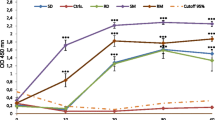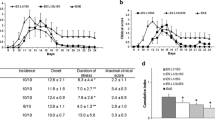Abstract
Three strains (ACI, August and Wistar) of rats previously sensitized by oral infection with intact third-stage larvae ofAngiostrongylus cantonensis developed significant protective immunity to challenge infections 6 weeks later. The degree of the immunity was highest in the August strain of rats, followed by Wistar and ACI rats. Protective immunity appears to affect both third-stage larvae and fourth- and/or fifth-stage worms. ACI rats showed poor antibody responses, especially in the IgE fraction. When 24-day-old young adult worms were transferred from the brain of donor rats into the peritoneal cavity of sensitized rodents, peritoneal eosinophils predominantly adhered to the worm surfaces in vivo.
Similar content being viewed by others
References
Alicata JE, Jindrak K (1970) Angiostrongylosis in the Pacific and Southeast Asia. Thomas Springfield, Ill
Au ACS, Ko RC (1979) Changes in worm burden, haematological and serological response in rats after single and multipleAngiostrongylus cantonensis infections. Z Parasitenkd 58:233–242
Bhaibulaya M (1975) Comparative studies on the life history ofAngiostrongylus mackerrasae Bhaibulaya, 1968 andAngiostrongylus cantonensis (Chen 1935). Int J Parasitol 5:7–20
Heyneman D, Lim BL (1965) Prolonged survival in rats immunized by a small number of low-level doses ofAngiostrongylus cantonensis and challenged with a lethal level of infective larvae. Med J Malaya 20:162–163
Kamath VR, Menon S, Ranapurkar DM (1986) Effect of UV-irradiation, spleen cells and MLN cells on protective immunity againstAngiostrongylus cantonensis infection in mice. Z Parasitenkd 72:221–226
Kamiya M, Klongkamnuankarn K, Harinasuta C (1971) Experimental infection ofAngiostrongylus cantonensis in rats by subcutaneous and intraperitoneal inoculations. Southeast Asian J Trop Med Public Health 2:233–236
Laubach H, Kocan AA, Sartain KE (1978) Effects of various numbers of adultAngiostrongylus cantonensis on lung lysophospholipase activities and bone marrow eosinophil levels of specific pathogen-free rats. J Parasitol 64:1145–1146
Lee SH (1969) The use of irradiated third-stage larvae ofAngiostrongylus cantonensis as antigen to immunize albino rats against homologous infection. Proc Helminthol Soc Wash 36:95–97
Ottolenghi A, Weatherly NF, Kocan AA, Larsh JE Jr (1977)Angiostrongylus cantonensis: phospholipase in nonsensitized and sensitized rats after challenge. Infect Immun 15:13–18
Ottolenghi A, Weatherly NF, Larsh JE Jr (1980) Phospholipase B in the brains and meninges of nonsensitized and sensitized rats after challenge withAngiostrongylus cantonensis. Infect Immun 29:799–807
Techasoponmani R, Sirisinha S (1980) Use of excretory and secretory products from adult female worms to immunize rats and mice againstAngiostrongylus cantonensis infection. Parasitology 80:457–469
Uahkowithchai V, Techasoponmani R, Sirisinha S (1977) Effect of immunization with metabolic antigens on experimental infection of rats withAngiostrongylus cantonensis. Southeast Asian J Trop Med Public Health 8:486–493
Young WK, Dobson C (1982a)The biology ofAngiostrongylus cantonensis larvae in immune rats. Southeast Asian J Trop Med Public Health 13:244–248
Young WK, Dobson C (1982b) Antibody responses in rats infected withAngiostrongylus cantonensis and the passive transfer of protective immunity with immune serum. Z Parasitenkd 67:329–336
Yong WK, Dobson C (1982c) The passive transfer of protective immunity againstAngiostrongylus cantonensis with immune lymph node cells from different lymphoid tissues in rats. Int J Parasitol 12:423–425
Yong WK, Glanville RJ, Dobson C (1983) The role of the spleen in protective immunity againstAngiostrongylus cantonensis in rats: splenectomy and passive spleen cell transfers. Int J Parasitol 13:165–170
Yoshimura K, Soulsby EJL (1976)Angiostrongylus cantonensis: lymphoid cell responsiveness and antibody production in rats. Am J Trop Med Hyg 25:99–107
Yoshimura K, Aiba H, Hirayama N, Yosida TH (1979a) Acquired resistance and immune responses of eight strains of inbred rats to infection withAngiostrongylus cantonensis. Jpn J Vet Sci 41:245–259
Yoshimura K, Aiba H, Oya H (1979b) Transplantation of young adultAngiostrongylus cantonensis into the rat pulmonary vessels and its application to the assessment of acquired resistance. Int J Parasitol 9:97–103
Yoshimura K, Uchida K, Sato K, Oya H (1983) Antibody-dependent adherence and damage to the young adult worms ofAngiostrongylus cantonensis by rat eosinophils in vitro. Jpn J Parasitol 32:489–500
Author information
Authors and Affiliations
Rights and permissions
About this article
Cite this article
Yoshimura, K., Ishida, K., Ishigooka, S. et al. Protective immunity againstAngiostrongylus cantonensis in rats following sensitizing infections. Parasitol Res 76, 26–31 (1989). https://doi.org/10.1007/BF00931067
Accepted:
Issue Date:
DOI: https://doi.org/10.1007/BF00931067




